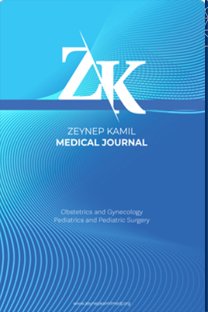Management of adnexal masses recognized incidentally during the cesarean: Our 5 years only central experience
Management of adnexal masses recognized incidentally during the cesarean: Our 5 years only central experience
___
- 1. Whitecar P, Turner S, Higby K. Adnexal masses in pregnancy: A review of 130 cases undergoing surgical management. Am J Obstet Gynecol 1999;181(1):19–24.
- 2. Nelson MJ, Cavalieri R, Graham D, Sanders RC. Cysts in pregnancy discovered by sonography. J Clin Ultrasound 1986;14(7):509–12.
- 3. Kohler M. The adnexal mass in pregnancy. Postgrad Obstet Gynecol 1994;14(12):1–5.
- 4. Sherard GB 3rd, Hodson CA, Williams HJ, Semer DA, Hadi HA, Tait DL. Adnexal masses and pregnancy: A 12-year experience. Am J Obstet Gynecol 2003;189(2):358–62.
- 5. Condous G, Khalid A, Okaro E, Bourne T. Should we be examining the ovaries in pregnancy? Prevalence and natural history of adnexal pathology detected at first‐trimester sonography. Ultrasound Obstet Gynecol 2004;24(1):62–6.
- 6. Cavaco-Gomes J, Moreira CJ, Rocha A, Mota R, Paiva V, Costa A. Investigation and management of adnexal masses in pregnancy. Scientifica 2016;2016:3012802.
- 7. Baser E, Erkilinc S, Esin S, Togrul C, Biberoglu E, Karaca MZ, et al. Adnexal masses encountered during cesarean delivery. Int J Gynecol Obstet 2013;123(2):124–6.
- 8. Zanetta G, Mariani E, Lissoni A, Ceruti P, Trio D, Strobelt N, et al. A prospective study of the role of ultrasound in the management of adnexal masses in pregnancy. BJOG 2003;110(6):578–83.
- 9. Patenaude Y, Pugash D, Lim K, Morin L, Bly S, Butt K, et al. The use of magnetic resonance imaging in the obstetric patient. J Obstet Gynaecol Can 2014;36(4):349–55.
- 10. Spitzer M, Kaushal N, Benjamin F. Maternal CA-125 levels in pregnancy and the puerperium. J Reprod Med 1998;43(4):387–92.
- 11. Ulker V, Gedikbasi A, Numanoglu C, Saygı S, Aslan H, Gulkilik A. Incidental adnexal masses at cesarean section and review of the literature. J Obstet Gynaecol Res 2010;36(3):502–5.
- 12. Horowitz NS. Management of adnexal masses in pregnancy. Clin Obstet Gynecol 2011;54(4):519–27.
- 13. Struyk A, Treffers P. Ovarian tumors in pregnancy. Acta Obstet Gynecol Scand 1984;63(5):421–4.
- 14. Thornton JG, Wells M. Ovarian cysts in pregnancy: Does ultrasound make traditional management inappropriate? Obstet Gynecol 1987;69(5):717–21.
- 15. Dede M, Yenen M, Yilmaz A, Goktolga U, Baser I. Treatment of incidental adnexal masses at cesarean section: A retrospective study. Int J Gynecol Cancer 2007;17(2):339–41.
- 16. Bernhard LM, Klebba PK, Gray DL, Mutch DG. Predictors of persistence of adnexal masses in pregnancy. Obstet Gynecol 1999;93(4):585–9.
- 17. Cengiz H, Kaya C, Ekin M, Yeşil A, Yaşar L. Management of incidental adnexal masses on caesarean section. Niger Med J 2012;53(3):132.
- 18. Yen CF, Lin SL, Murk W, Wang CJ, Lee CL, Soong YK, et al. Risk analysis of torsion and malignancy for adnexal masses during pregnancy. Fertil Steril 2009;91(5):1895–902.
- 19. Leiserowitz GS, Xing G, Cress R, Brahmbhatt B, Dalrymple JL, Smith LH. Adnexal masses in pregnancy: How often are they malignant? Gynecol Oncol 2006;101(2):315–21.
- 20. Trimble EL. The NIH consensus conference on ovarian cancer: Screening, treatment, and follow-up. Gynecol Oncol 1994;55(3):S1–3.
- ISSN: 1300-7971
- Yayın Aralığı: Yılda 4 Sayı
- Yayıncı: Ali Cangül
Hasan Hüseyin MUTLU, Elif YÜKSEL KARATOPRAK, Müferet ERGÜVEN, Nilüfer ÇETİNER
PET/CT dilemma in para-aortic lymph node assessment in locally advanced cervical cancer?
Tayup ŞİMŞEK, Selen DOĞAN, Özer BİRGE, Mehmet Sait BAKIR, Hasan Aykut TUNCER, Ceyda KARADAĞ
Oncologic breast surgery of retroareolar breast cancer with racquet mammoplasty technique
Semih BOLU, Fatih İŞLEYEN, Ayşegül DANIŞ
Bilateral serous macular detachment as a complication of preeclampsia: A case report
Özkan KOCAMIŞ, Emine TEMEL, Kemal ÖRNEK, Nazife Aşıkgarip
Acute dystonia after domperidone use: A rare and an unexpected side effect
Salih DEMİRHAN, Özlem ERDEDE, Rabia Gönül SEZER YAMANEL
Ebru ÇÖĞENDEZ, Önder TOSUN, Mahmut ERDEMOĞLU
Evaluation of the relationship between method of delivery and breastfeeding characteristics
